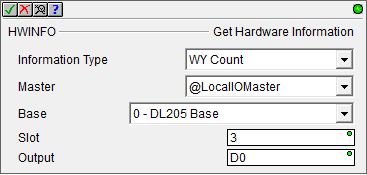Topic: DMD0158
HWINFO - Get Hardware Information
The Get Hardware Information (HWINFO) instruction is used to retrieve hardware-specific information from an I/O module. This instruction allows a Do-more CPU to confirm at runtime that an I/O module is present, or missing; or confirm that a module in a particular slot has the required I/O count, etc. This instruction is also useful for determining if an I/O module that is marked as "Optional" in the I/O Configuration is present at runtime.

Parameters:
Note: Use the F9 key or click the 'three dot box' at the right edge of the parameter field to open the Default Element Selection Tool (the Element Picker or the Element Browser) or use the Down-Arrow key (Auto-Complete) on any parameter field to see a complete list of the memory locations that are valid for that parameter of the instruction.
Information Type selects which piece of information to retrieve from the module in the specified I/O slot:
Module ID gets the module's factory-assigned ID:
The list of Module IDs for Discrete Input, Discrete Output, and Combination Discrete modules in the BRX, DL205 and Terminator series is available here: Discrete I/O Modules.
The list of Module IDs for Analog Input, Analog Output, and Combination Analog modules in the BRX, DL205 and Terminator series is available here: Analog I/O Modules.
The list of Module IDs for Ethernet and Serial Communication modules in the DL205 and Terminator series is available here: Communication Modules.
The list of Module IDs for CTRIO and CTRIO2 modules in the DL205 and Terminator series is available here: CTRIO / CTRIO2 Modules.
X Count gets the number of discrete input points.
Y Count gets the number of discrete output points.
WX Count gets the number of signed WORD (16-bit) locations for analog inputs.
WY Count gets the number of signed WORD (16-bit) locations for analog outputs.
X Map gets the offset of the first X location where the module is mapped.
Y Map gets the offset of the first Y location where the module is mapped.
WX Map gets the offset of the first WX location where the module is mapped.
WY Map gets the offset of the first WY location where the module is mapped.
Master selects which of the configured I/O Masters has access to the Base containing the target I/O module. For more information on I/O Masters see the I/O Configuration section of the System Configuration help topic.
Select LocalIOMaster for modules located in the base with the Do-more CPU.
Select $EthIOMaster for modules installed in Ethernet I/O Slave bases.
Base selects which base contains the target I/O module. This list will contain the an entry for the local I/O base and all of the currently configured Ethernet I/O slaves (if they exist).
Slot specifies which slot contains the target I/O module. This can only be a constant value between 0 and 15.
BRX systems begin with slot 0 meaning the on-board I/O, and slot 1 is the first expansion I/O module position.
DL205 systems begin with slot 0 in the module slot adjacent to the CPU.
Terminator systems begin with slot 0 as the first expansion I/O module position.
Output specifies a numeric location to store the resulting data. This can be any writable numeric location.
A returned value of -1 (0xFFFF) indicates the query failed; this typically means either the slot is empty, or an invalid slot was specified.
Related Topics:
DEVREAD - Read Device Register
DEVWRITE - Write Device Register
RD - Read From Intelligent Module
WT - Write To Intelligent Module
See Also:
DATAINFO - Query Information about Data Memory
Rung Example:

